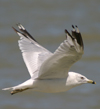|
||||||||||||||||||||||||||||||||||||||||||||||||||||||||||||||||||||||||||||||
Coordinators: 1cy June 2cy Jan 3cy Jan adult Jan |
adult: AugustIn the spring of 2007, the City of Chicago and the USDA Wildlife Services conducted a study on two Ring-billed Gull colonies in Chicago, IL. The study was an egg-oiling project initiated by the City. The goal was to determine whether oiling eggs during the nesting season would reduce the number of gulls on local beaches. Ordinary corn oil is one way to prevent oxygen from penetrating the eggshell, thus preventing the young from ever hatching. Adult parents continue to incubate and invest energy in nesting, but to no avail. This is, as one of my friends put it "murder in a non-lethal way".
The findings of this study were not instantaneous since subsequent hatch-year numbers had to be reviewed. Data was collected by biologists with the USDA Wildlife Services from April of 2007 through April of 2009. During this time, the public was called on to report any tagged gulls. The USDA used press releases and online announcements to garner the input of many birding organizations. Resightings were reported from some twenty different states (and one Canadian province). Unsurprisingly, many of the winter resightings came from the Gulf Coast states; this agrees with earlier studies regarding the movements of Ring-billeds on the Great Lakes (Gabrey, 1996). Also of interest to me is that no tagged RBGUs were reported in Chicago during the winter seasons. This reinforces my suspicion that Chicago Ring-billeds are replaced by a different population during the winter months.
Interestingly, there was approximately a 3 to 1 ratio of yellow and orange-tagged resightings over blue and green-tagged birds. Why this color bias existed is still unknown.The biologists and volunteers who conducted regular spot counts at the breeding colonies (at least twice per week) also recorded a similar color bias. Having reported two of these tagged gulls myself (Amar), I felt obligated to get details about this program and so I contacted the Supervisory Wildlife Biologist from the USDA, Thomas W. Seamans. It seemed odd to me that a relatively small percentage of the control group was reported, while a much, much, greater amount of resightings came from the treatment group. This struck me as backwards! Seamans admitted that "there is a problem with this marking technique [patagial tags] that could really cause a misinterpretation of data collected by biologists". He also added that "if we had been looking at long term movements then it [the tagging program] would have been a problem". Over 97% of the nests with oiled eggs from the 2007 breeding season effectively failed. Nests that were not oiled did not suffer any "complete" clutch loss (Rader, 2008). One might argue that the City of Chicago was not trying to eliminate the entire population of both colonies but I would beg to differ. The only reason why a good percentage of nests were left unoiled in the Lake Calumet colony is because the City would have exceeded the Federal and State permits for the project (the City underestimated the number of nests on its permit application). |
|||||||||||||||||||||||||||||||||||||||||||||||||||||||||||||||||||||||||||||
 Ring-billed Gull delawarensis 221 adult, August 21 2009, Wells Beach ME. Picture: Kathleen Hansen. Ring-billed Gull delawarensis 221 adult, August 21 2009, Wells Beach ME. Picture: Kathleen Hansen. |
||||||||||||||||||||||||||||||||||||||||||||||||||||||||||||||||||||||||||||||
 Ring-billed Gull delawarensis 224 adult, August 31 2011, Bangor, Penobscot Co., ME. Picture: Jonathan Mays. Ring-billed Gull delawarensis 224 adult, August 31 2011, Bangor, Penobscot Co., ME. Picture: Jonathan Mays. |
||||||||||||||||||||||||||||||||||||||||||||||||||||||||||||||||||||||||||||||
 Ring-billed Gull delawarensis 70H adult, August 2014 & September 2015, Sandy Point State Reservation, Plum Island, Ipswich, MA. Picture: Steve Arena. Ring-billed Gull delawarensis 70H adult, August 2014 & September 2015, Sandy Point State Reservation, Plum Island, Ipswich, MA. Picture: Steve Arena. |
||||||||||||||||||||||||||||||||||||||||||||||||||||||||||||||||||||||||||||||
 Ring-billed Gull delawarensis adult, August 06 2010, Sea Girt, New Jersey. Picture: Pablo Mendoza. Ring-billed Gull delawarensis adult, August 06 2010, Sea Girt, New Jersey. Picture: Pablo Mendoza. |
||||||||||||||||||||||||||||||||||||||||||||||||||||||||||||||||||||||||||||||
 Ring-billed Gull delawarensis adult, August 19 2013, Miquelon Lake - Camrose, Alberta, Canada. Picture: Gerry Beyersbergen. Ring-billed Gull delawarensis adult, August 19 2013, Miquelon Lake - Camrose, Alberta, Canada. Picture: Gerry Beyersbergen. |
||||||||||||||||||||||||||||||||||||||||||||||||||||||||||||||||||||||||||||||
 Ring-billed Gull delawarensis adult, August 19 2011, Gatineau Park, Québec. Picture: Ken Sominite. Ring-billed Gull delawarensis adult, August 19 2011, Gatineau Park, Québec. Picture: Ken Sominite. |
||||||||||||||||||||||||||||||||||||||||||||||||||||||||||||||||||||||||||||||
 Ring-billed Gull delawarensis adult, August 25 2011, Ottawa, Ontario, Canada. Picture: Ken Simonite. Ring-billed Gull delawarensis adult, August 25 2011, Ottawa, Ontario, Canada. Picture: Ken Simonite. |
||||||||||||||||||||||||||||||||||||||||||||||||||||||||||||||||||||||||||||||
 Ring-billed Gull delawarensis adult, August 13 2006, Ottawa NWR - Lake Erie, Ohio. Picture: Steve Hamilton. Ring-billed Gull delawarensis adult, August 13 2006, Ottawa NWR - Lake Erie, Ohio. Picture: Steve Hamilton. |
||||||||||||||||||||||||||||||||||||||||||||||||||||||||||||||||||||||||||||||
 delawarensis Ring-billed Gull
delawarensis Ring-billed Gull